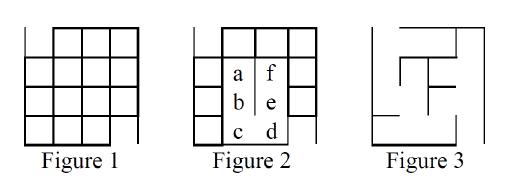Question
Implement in Java . Also post the JUnit test case. DFS and BFS for the solution of MAZE . Generating a Maze: To generate a
Implement in Java . Also post the JUnit test case. DFS and BFS for the solution of MAZE .
Generating a Maze:
To generate a maze, first start with a grid of rooms with walls between them. The grid contains r
rows and r columns for a total of r*r rooms. For example, Figure 1 is a 4x4 grid of 16 rooms. The
missing walls at the top left and bottom right of the maze border indicate the starting and finishing
rooms of the maze.

Our objective here is to create a perfect maze (see Figure 3), the simplest type of maze for a
computer to generate and solve. A perfect maze is defined as a maze which has one and only one
path from any point in the maze to any other point. This means that the maze has no inaccessible
sections, no circular paths, no open areas.
Now, begin removing interior walls to connect adjacent rooms. The difficultly in generating a perfect
maze is in choosing which walls to remove. Walls should be removed to achieve the following maze
characteristics:
1. Randomized: To generate unpredictable different mazes, walls should be selected randomly
as candidates for removal.
2. Single solution: There should be only one path between the starting room and the finishing
room (for simplicity always use as starting and finishing rooms the ones in Figure 1, i.e. ,
starting the upper left room and finishing the lower right room) . Unnecessarily removing too
many walls will make the maze too easy to solve. Therefore, a wall should not be removed if
some other path already connects the two rooms on either side of the wall. For example, in
2
Figure 2, the wall between a and f should not be removed because walls have previously
been removed that create a path between a and f through b, c, d, e.
3. Fully connected: Enough walls must be removed so that every room (therefore also the
finishing room) is reachable from the starting room. There must be no rooms or areas that
are completely blocked off from the rest of the maze.
We now give a simple maze generation algorithm and that uses Depth First Search. Here's the DFS
algorithm written as pseudocode:
create a CellStack (LIFO) to hold a list of cell locations
set TotalCells= number of cells in grid
choose the starting cell and call it CurrentCell
set VisitedCells = 1
while VisitedCells
find all neighbors of CurrentCell with all walls intact
if one or more found choose one at random
knock down the wall between it and CurrentCell
push CurrentCell location on the CellStack
make the new cell CurrentCell
add 1 to VisitedCells
else
pop the most recent cell entry off the CellStack
make it CurrentCell
Note that we can eliminate recursion by the use of a stack (this DFS implementation differs from the
one we have seen in class).
When the while loop terminates, the algorithm is completed. Every cell has been visited and thus no
cell is inaccessible. Also, since we test each possible cell to see if we've already been there, the
algorithm prevents the creation of any open areas, or paths that circle back on themselves.
After generating a maze, your program should solve the maze (find a path from the starting room to
the finishing room)
1. using DFS and
2. using BFS.
3
Each search algorithm will begin at the starting room and search for the finishing room by traversing
wall openings. The search should terminate as soon as the finishing room is found. For each search
algorithm, you will output the order in which rooms where visited and indicate the shortest solution
path from starting to finishing room.
Input: The program should accept the number of rows and columns r of the maze (use only r=4, 5,
6, 7, 8, 10).
Output: The program should print the maze, then the DFS solution, then the BFS solution
Figure 1 Figure 2 Figure 3 Figure 1 Figure 2 Figure 3Step by Step Solution
There are 3 Steps involved in it
Step: 1

Get Instant Access to Expert-Tailored Solutions
See step-by-step solutions with expert insights and AI powered tools for academic success
Step: 2

Step: 3

Ace Your Homework with AI
Get the answers you need in no time with our AI-driven, step-by-step assistance
Get Started


